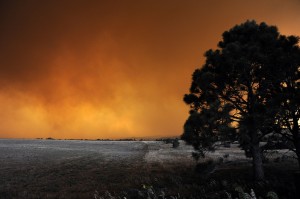The fires in Colorado are without precedent in size, scope, and the damage they are causing. The Waldo Canyon fire around Colorado Springs has destroyed almost 350 houses and killed at least one person. It threatened the Air Force Academy, which was under a mandatory evacuation order. President Obama is planning to fly out to Colorado today to tour the affected area.
 There is a tendency to want to blame someone – and the FBI has actually begun an investigation into the damaging Waldo Canyon fire to see if arson was a possible cause. Unfortunately, the cause of the fires is both easier to find, and harder to do anything about: a warming climate caused by centuries of fossil fuel emissions.
There is a tendency to want to blame someone – and the FBI has actually begun an investigation into the damaging Waldo Canyon fire to see if arson was a possible cause. Unfortunately, the cause of the fires is both easier to find, and harder to do anything about: a warming climate caused by centuries of fossil fuel emissions.
Climate scientists generally hedge about the link between extreme events and a changing global climate, saying things like what Colorado State Climatologist Nolan Doesken said when asked about the link between the wildfires and climate change: “Extremes happen independent of climate change, but they would happen more often if the word of the climate scientists is held up.” Unfortunately, that leads to headlines like this one in the Coloardan: Climate change no clear culprit for weather extremes.
 This is simply not true. Extreme droughts and heatwaves like the ones driving the Colorado fires are exactly what we should expect from a changing climate: essentially, greenhouse gasses are acting like steroids for extreme weather.
This is simply not true. Extreme droughts and heatwaves like the ones driving the Colorado fires are exactly what we should expect from a changing climate: essentially, greenhouse gasses are acting like steroids for extreme weather.
Earlier this year, the IPCC, in its report on Managing the Risks of Extreme Events and Disasters explicitly said that extreme weather events like droughts, floods, or storms are becoming more prevalent as the global climate warms. Further, the US Global Change Research Program (globalchange.gov) – an initiative begun under the Bush Administration to better understand how climate change will impact U.S. domestic territory – said in its 2009 regional impacts assessment of the Southwest (including the Colorado Mountains) that “Recent warming in the Southwest has been among the most rapid in the nation.” The report then goes on to state that:
“Record-setting wildfires are resulting from the rising temperatures and related reductions in spring snowpack and soil moisture.”
When actual events mimic so closely the events predicted as a feature of changes in the global climate, we should heed the warning.
When we talk about the effect of climate change on security, we mostly think about how droughts or floods in far-away lands will cause migrations or resource shortages, leading to conflict. Threats like this may mean we need to re-think this paradigm: our government’s prime duty is to protect the security of its citizen’s life, liberty and property. When we see wildfires fueled by a warming climate that are burning people’s homes and killing people, that is a clear threat to our security.
While we know that droughts have happened in the past, and wildfires have always been a feature of the Rocky Mountain ecosystem, when we hear from longtime observers that these events are “epic” or “extreme,” we should understand that something is happening. I understand the scientist’s measured response, but at the same time, it is someone’s duty to be clear, so I will say it: climate change caused by centuries of human emissions has caused the American southwest to become warmer and more drought prone, making catastrophic fires more likely. Or, more clearly: these wildfires are directly linked to global climate change.


